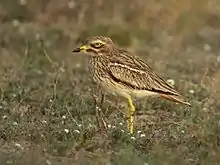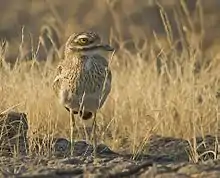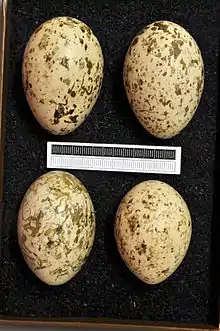Eurasian stone-curlew
The Eurasian stone-curlew, Eurasian thick-knee, or simply stone-curlew (Burhinus oedicnemus) is a northern species of the Burhinidae (stone-curlew) bird family.
| Eurasian stone-curlew | |
|---|---|
 | |
| Scientific classification | |
| Kingdom: | Animalia |
| Phylum: | Chordata |
| Class: | Aves |
| Order: | Charadriiformes |
| Family: | Burhinidae |
| Genus: | Burhinus |
| Species: | B. oedicnemus |
| Binomial name | |
| Burhinus oedicnemus | |
 | |
| Range of B. oedicnemus Breeding range Year-round range Wintering range | |
| Synonyms | |
|
Charadrius oedicnemus Linnaeus, 1758 | |

Etymology
The genus name Burhinus comes from the Greek bous, ox, and rhis, nose. The species name oedicnemus comes from the Greek oidio, to swell, and kneme, the shin or leg, referring to the bird's prominent tibiotarsal joints,[2] which also give it the common name of "thick-knee". This is an abbreviated form of Pennant's 1776 coinage "thick kneed bustard".[3]
The name "stone curlew" was first recorded by Francis Willughby in 1667 as a "third sort of Godwit, which in Cornwall they call the Stone-Curlew, differing from the precedent in that it hath a much shorter and slenderer Bill than either of them".[4] It derives from the bird's nocturnal calls sounding like the unrelated Eurasian curlew Numenius arquata and its preference for barren stony heaths.[3]
In his Bird Watching (1901) Edmund Selous uses the name "great or Norfolk plover" (Œdicnemus Crepitans).[5]
Description
It is a fairly large wader though is mid-sized by the standards of its family. Length ranges from 38 to 46 cm (15 to 18 in), wingspan from 76 to 88 cm (30 to 35 in) and weight from 290 to 535 g (10.2 to 18.9 oz).[6][7] with a strong yellow and black beak, large yellow eyes (which give it a "reptilian", or "goggle-eyed" appearance), and cryptic plumage. The bird is striking in flight, with black and white wing markings.
Habits

Despite being classed as a wader, this species prefers dry open habitats with some bare ground. It is largely nocturnal, particularly when singing its loud wailing songs, which are reminiscent of that of curlews. Food consists of insects and other small invertebrates, and occasionally small reptiles, frogs and rodents. It lays 2–3 eggs in a narrow scrape in the ground.
Range and status
The Eurasian stone curlew occurs throughout Europe, north Africa and southwestern Asia. It is a summer migrant in the more temperate European and Asian parts of its range, wintering in Africa. Although the species is of Least Concern, some populations are showing declines due to agricultural intensification. For example, a French population has declined with 26% over 14 years.[8]
Subspecies
There are five subspecies of Burhinus oedicnemus:[9] The Indian stone-curlew Burhinus indicus was previously considered a subspecies.
- Burhinus oedicnemus distinctus (Bannerman, 1914) – Found on the central and western Canary Islands[10]
- B. o. harterti Vaurie, 1963 – Found from west Kazakhstan to Pakistan and northwestern India
- B. o. insularum (Sassi, 1908) – Found on the eastern Canary Islands[10]
- B. o. oedicnemus (Linnaeus, 1758) – Found in western and southern Europe to the Balkans, Ukraine and Caucasus
- B. o. saharae (Reichenow, 1894) – Found in northern Africa and the Mediterranean islands to Iraq and Iran
References
- BirdLife International (2014). "Burhinus oedicnemus". IUCN Red List of Threatened Species. 2014. Retrieved 28 June 2015.
- Jobling, James A (2010). The Helm Dictionary of Scientific Bird Names. London: Christopher Helm. pp. 81, 280. ISBN 978-1-4081-2501-4.
- Lockwood, W.B. (1993). The Oxford Dictionary of British Bird Names. OUP. ISBN 978-0-19-866196-2.
- Penhallurick, R.D. (1969). Birds of the Cornish Coast. Truro: D. Bradford Barton Ltd. ISBN 978-0851530086.
- Selous, Edmund (1901). . London: Dent & Co. OCLC 1317886 – via Wikisource., p. 4, 6.
- "Eurasian Thick-knee - Burhinus oedicnemus". www.birdsinbulgaria.org. Birds in Bulgaria. 2011.
- Dunning, John B. Jr., ed. (1992). CRC Handbook of Avian Body Masses. CRC Press. ISBN 978-0-8493-4258-5.
- Gaget, Elie; Fay, Remi; Augiron, Steve; Villers, Alexandre; Bretagnolle, Vincent (2019). "Long-term decline despite conservation efforts questions Eurasian Stone-curlew population viability in intensive farmlands" (PDF). Ibis. 161 (2): 359–371. doi:10.1111/ibi.12646. ISSN 1474-919X.
- Peterson, Alan P. (2013). "Zoonomen Nomenclatural data". zoonomen.net. Retrieved 28 June 2015.
- Tosco, Rubén Barone; Siverio, Felipe; Trujillo, D. (1992). "Datos recientes sobre el Alcaraván (Burhinus oedicnemus L. 1758) en la Isla de La Palma (Canarias): notas" [Recent data on the Stone Curlew (Burhinus oedicnemus) on La Palma (Canary Islands): notes]. Vieraea: Folia scientarum biologicarum canariensium (in Spanish). 21: 168. ISSN 0210-945X.
External links
| Wikimedia Commons has media related to Burhinus oedicnemus. |
| Wikispecies has information related to Burhinus oedicnemus. |
- Eurasian stone-curlew media from ARKive

- Ageing and sexing (PDF; 4.7 MB) by Javier Blasco-Zumeta & Gerd-Michael Heinze
- BirdLife species factsheet for Burhinus oedicnemus
- "Burhinus oedicnemus". Avibase.

- "Stone-curlew media". Internet Bird Collection.
- Eurasian stone-curlew photo gallery at VIREO (Drexel University)
- Audio recordings of Eurasian stone-curlew on Xeno-canto.
